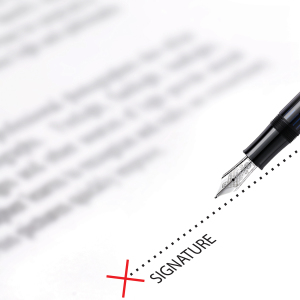Dispensing With the John Hancock
I just left the DMV in midtown Manhattan. Let’s place my current emotional state somewhere in the sixth circle of Hell (Heresy), smack dab between Anger and Violence.
In truth, it wasn’t as dreadful as you might imagine. With facilitators armed with tablets to constantly update customers on their expected wait times and plenty of city bureaucrats to process paperwork, I was in and out in around 45 minutes. But during my time there, I must have signed my name 15 times, each scrawl looking a little less legible and feeling less like a stamp of authenticity and more like an excessive burden with little meaning in a digital world.
So I ask: is the signature dead? What relevance does your John Hancock have in today’s wired society?
Online security is a major concern: we do our banking, purchasing, and all types of registration via dubiously secure wireless connections. These electronic systems mostly dispense of the signature, using encryption, Chip and Pin, secure passwords, and even biometric measures to verify users’ identities and secure their stamps of e-approval. When paper checks were the most common form of payment, the signature was a vital part of the document. Now, your PIN number is far more significant than that cursive squiggle. And heck, who even learns cursive anymore? Does your 8-year-old practice D’Nealian script the way I did in school? Doubtful. Who has time for that when standardized test prep is all teachers have time to cover in hopes of no child being left behind?
It’s clear that it isn’t just young people and current students whose penmanship has contributed to the devolution of the signature. When Treasury Secretary Jack Lew’s chicken scratch was mass reproduced on trillions of dollars of US currency, we became a bit of an international laughingstock. But why? Should Lew – or we as Americans – be ashamed? What’s more personal than a signature? Do its aesthetics really matter?
What if you’re sick of signing and just want to get the hell out of the DMV?, wondered the harried city dweller whose new license won’t arrive for a couple weeks. What will it look like? Should I be ashamed?
In a paperless economy, what role does a signature really play? For celebrities, the autograph may always be an important personal item with potential collectors’ value. But wouldn’t a fingerprint be a more secure way to verify that you are in fact the person whose name is printed on that AMEX?
While I’ll always be a proponent of the written word and a stalwart defender of its vitality, I’m not so sure the signature is that relevant in the modern world. Sure, it belongs at the bottom of a personal letter, but who writes those anymore? While I’ve previously lampooned myself for my affinity for emojis and am quick to defend the Oxford comma, I think I now find myself solidly in the opposite army: I’d like to see more biometrics and secure encryption technology like Chip and Pin to secure financial transactions and less reliance on the signature. It’s too easily forged, widely neglected, and downright irksome to have to create. Let’s upgrade our security and dispense with this one element of the written word that is now little more than a remembrance of another era. It belongs in museums on the bottom of historical documents, not on your government-issued ID or financial statements.
Kathryn Cunningham is a professional writer and social media maven. Dividing her time between her home in midtown Manhattan and many homes on the road, she enjoys supporting the arts in small communities and advocating for rescue dogs.


